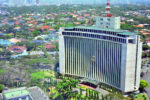The Department of Transportation (DOTr) is urging local government units (LGUs) to step up the adoption of mobility programs with the use of human power to get from one point to the next.
Elaborately called active transport infrastructure, such programs benefit cyclists and pedestrians while reducing traffic congestion.
Transportation Secretary Jaime J. Bautista said the proper use of bike lane networks across the country requires an effective adoption or enforcement of the infrastructure by concerned government agencies.
“Perhaps proper enforcement is needed so that we can properly use our bike lanes,” Bautista said at the inauguration of such active transport infrastructure in San Fernando, Pampanga on Monday.
He urged the Land Transportation Office (LTO), the Philippine National Police (PNP) and local government units (LGUs) strictly to enforce active transport measures, including the proper use of bike lanes.
“That’s why I’m calling on our law enforcers, the LTO, our police officers to use these bike lanes properly,” Bautista said.
No less than President Ferdinand Marcos Jr. himself announced the prime importance of pedestrian and bicycle infrastructure as alternative modes of transport, Bautista said in stressing the benefits of active transport.
“Active transport not only supports the riding public but also reduces traffic, encourage health programs so the DOTr has bike lanes all over the country,” he said.
The active transport infrastructure in San Fernando, Pampanga spans over 37.5 kilometers of bike lanes along Jose Abad Santos Avenue, the Manila North Road, and Lazatin and Capitol Boulevards.
The DOTr is implementing the active transport program under the National Transport Policy and the Philippine Development Plan 2023 – 2028 initiatives. The program has a budget of P5 billion this year alone.







